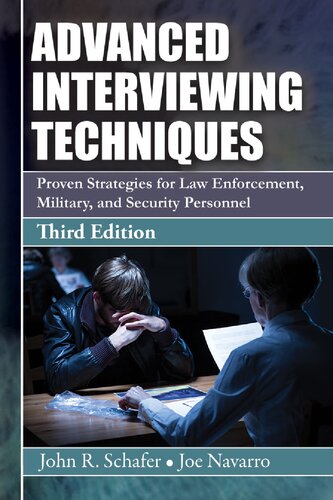

Most ebook files are in PDF format, so you can easily read them using various software such as Foxit Reader or directly on the Google Chrome browser.
Some ebook files are released by publishers in other formats such as .awz, .mobi, .epub, .fb2, etc. You may need to install specific software to read these formats on mobile/PC, such as Calibre.
Please read the tutorial at this link. https://ebooknice.com/page/post?id=faq
We offer FREE conversion to the popular formats you request; however, this may take some time. Therefore, right after payment, please email us, and we will try to provide the service as quickly as possible.
For some exceptional file formats or broken links (if any), please refrain from opening any disputes. Instead, email us first, and we will try to assist within a maximum of 6 hours.
EbookNice Team

Status:
Available0.0
0 reviews(Ebook) Advanced Interviewing Techniques Proven Strategies for Law Enforcement Military and Security Personnel 3rd Edition by John R Schafer, Joe Navarro - Ebook PDF Instant Download/Delivery: 9780398091231 ,0398091234
Full download (Ebook) Advanced Interviewing Techniques Proven Strategies for Law Enforcement Military and Security Personnel 3rd Edition after payment

Product details:
ISBN 10: 0398091234
ISBN 13: 9780398091231
Author: John R Schafer, Joe Navarro
(Ebook) Advanced Interviewing Techniques Proven Strategies for Law Enforcement Military and Security Personnel 3rd Edition Table of contents:
Chapter 1 - Planning the Interview
Selecting the Interviewer
Number of Interviewers
The Advantages of a Second Interviewer
Using the Second Interviewer to Test for Veracity
Age of the Interviewer
Gender of the Interviewer(s)
Interview Objectives
The Interview as Theater
Time of Day to Conduct an Interview
Note Taking
The Learning Curve
Chapter 2 - The Interview Setting
Physical Space
Obstacles
Chair Placement within a Room
Chair Configuration
Chair Configuration to Gain Cooperation
Chair Configuration to Reward or Reprimand
Chair Configuration to Assess Anxiety
Chair Configuration to Maximize Reading Nonverbal Cues
Chair Placement for a Second Interviewer
Chair Placement for a Third Party
Chapter 3 - Props
File Cabinets
Documents
Case Files
Security Camera
Photographs
A Coconspirator
Chapter 4 - Assessing the Interviewee
Social Indices
Desk Configurations
Age
Drug-dependent Persons
Personality Disorders and Mental Illness
Chapter 5 - Establishing Dominance
I. The Controlled Interview Environment
Controlling Time
Controlling Space
The Last Person Standing
Refreshments
Principle of Reciprocity
Predisposition to Talk Over Food
Controlling the Interview Agenda
Controlling the Interview Pace
Establish a Parent/Child Relationship
II. Uncontrolled Interview Environments
Seating Arrangements
Chair Selection
Repositioning Furniture
The Last Person Standing
Fully Occupy the Furniture
Invading Private Office Space
Usurping Space
Controlling Time
Chapter 6 - Rapport
I. Building Rapport
Smiling
The Eyebrow Flash
The Head Tilt
Names and Formal Titles
Conversational Encouragers
Cross Matching
Mirroring Language
Determining Dominant Language Medium
Mirror Dress
Touching
Ask a Favor
Flattery
Allow People to Flatter Themselves
Self-Disclosure
Building Rapport with Victims
Secondary Victimization
II. Testing for Rapport
Mirroring Gestures
Head Tilting
Open Posture
Breathing
Barriers
Setting Rapport Traps
Arrestee’s Psychological Time Line
Chapter 7 - Miranda Warnings
Perception of Control
Do You Think I Need a Lawyer?
Miranda Waiver
Chapter 8 - Detecting Deception
A Two-Stage Process
Guilty Knowledge or Guilty Action
Truth Forms a Comprehensive Whole
Liars Described
Detection Apprehension
But I Told You the Truth
Barriers
The Four-Domain Model of Detecting Deception2
1. Comfort/Discomfort
2. Emphasis
3. Synchrony
4. Perception Management
Summary of the Four Domain Model of Deception
Chapter 9 - Nonverbal Behavior
Proxemics
Territorial Displays
Sitting Displays
Stance
Staring
Posture
Attire
Eye Blocking
Eyes
Eyelid Flutter
Eye Rolling
Eye Blink
Eye Pointing
Lips
Mouth Quiver
Throat Clearing
Facial Touching
Hand to Neck
Hand to Cheek
Hand to Chest
Suprasternal Notch
Palms Up
Interlaced Fingers
Partial Smiles
Arm Block
Hand on Armrests
Illustrators
Pacifying Gestures
Grooming and Preening
Crossed Legs
Feet Pointing
Jittery Feet
Assurance and Confidence
Emphatic Gestures
Body Inclination
Posture
First Look
Cognitive Load
Chapter 10 - Verbal Clues to Deception
I. Clues to Detect Deception
Convince or Convey
Be a Skeptic
Positive Verbal and Nonverbal Signals
Negative Verbal and Nonverbal Signals
Converting a Positive Statement
Verb Tense
Passive Voice
Future in the Past
Little Words Can Signal Big Lies
Prepositions
Articles
Pronouns
Introjections
Indirect Answers
Speech Interrupters
Contractions
Voice Pitch
Details
Negative Events
Text Bridges
Spontaneous Negations
Stalling Ploys
II. Testing the Truth
Punishment
Process of Elimination
Testing an Alibi
Poor Man’s Polygraph
Chapter 11 - The Art of Questioning
Purpose of Questions
Basic Interrogators
“Wh” Questions
Presumptive Questions
Questions That Confirm Previously Known Information
Declarative Questions
Emphatic Question
Polar Questions
Chatper 12 - The Interviewing Tool Box
Pressure
Patience
Silence
Set High Expectations
Establish a Pattern of Anwering Questions
Storytelling
Twenty Questions
Teacher/Student Relationship
Confession by a Hundred Admissions
Probe and Excuse
Ethical Trap
Fill in the Dots
Presumptive
Accepting Possibilities
You Choose
Teach Me
Pencils Have Erasers
Now or Never
Us Against Them
Get the Interviewee to Request a Polygraph Examination
Everybody Makes Mistakes
Persuade—Don’t Negotiate
Created Power
Implicit Communication
Tell a Secret
The Ambush
When It Rains, It Pours
Re-interview
Multiple Interviews
Inoculation
Chatper 13 - The Anger Cycle
Provide an Explanation
Presumptive Statement
You Choose
Aggressive Probing
Chapter 14 - Breaking the Impasse and Other Problems
Confronting Resistance
Pick a Number—Any Number
Up the Proverbial Waterway
The Sleep of the Righteous
Get Up and Go
Do You Feel Lucky?
Your Only Chance to Tell Your Side
Force Movement
Saving Face
Reasons for Cooperating
Hard Questions
Chapter 15 - The End Game
Thank the Interviewee/Suspect
Resolve Dissonance
Provide Hope
Recontact
Escort the Interviewee to the Exit
The Interview Postmortem
REFERENCES
People also search for (Ebook) Advanced Interviewing Techniques Proven Strategies for Law Enforcement Military and Security Personnel 3rd Edition:
interviewing techniques for the interviewer
basic interviewing techniques
advanced interviewing techniques coursera
advanced interviewing techniques proven strategies for law enforcement
advanced interviewing
Tags: John R Schafer, Joe Navarro, Interviewing Techniques, Law Enforcement Military, Security Personnel